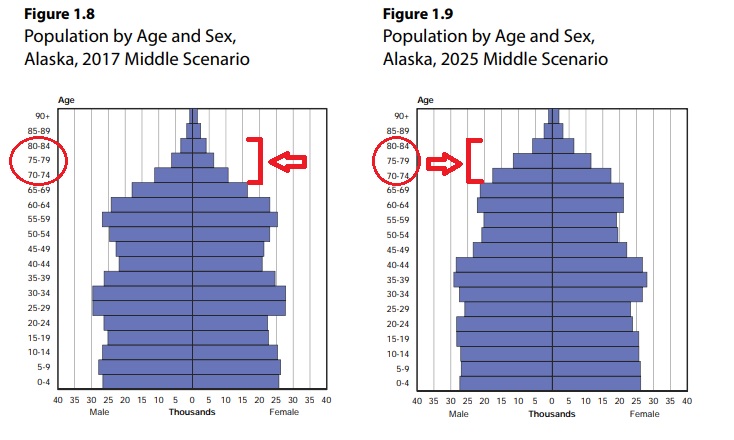
In this image from the Alaska Department of Labor, the demographic shift in Alaska’s population is most noticeable in the 70-and-older group. “Younger seniors” — those in their 60s — show a slight decrease. (Source: Alaska Department of Labor)
Proportionally, Alaska is growing older faster than any other state. And Southeast Alaska is growing oldest the fastest.
This aging trend in Alaska’s demographics is called the “Silver Tsunami,” says Erin Walker-Tolles, executive director of Catholic Senior Service, which operates Sitka’s Swan Lake Senior Center, the Care-a-Van, Meals-on-Wheels — and related services out of 11 offices in Southeast Alaska.
Walker-Tolles addressed the Sitka Economic Forum in April, and then was invited back in May to speak to the Chamber of Commerce.
In her remarks, she put numbers to the “Silver Tsunami.”

Catholic Community Service is “affiliated with the Catholic Church, but is not the church,” says executive director Erin Walker-Tolles. With 11 offices in Southeast Alaska, CCS is tracking the “Silver Tsunami” expected to hit the region by 2030. “It’s going to crash hard, guys,” she told the Sitka Chamber of Commerce. (KCAW photo/Robert Woolsey)
It’s already started to come, but it’s going to crash hard, guys. From 2015 to 2030 — these are Department of Labor statistics — it looks like Sitka’s supposed to decrease by 21 people, 2.7-percent overall, but increase the seniors group by 31-percent. That’s in less than 15 years. So you’re seeing a dramatic increase in the number of seniors, and a decrease in the number of working people to contribute to the economy to support those seniors. So there’s that. Now if you look at what it’s going to be like in 2030, there are going to be more people age 70-74 than any other group. And all the other older groups are going to increase. In your younger group — you’re going to have less younger seniors here. This trend is going to continue. So you’re looking at the prospect of a lot more frail, older seniors. And of course the level of support and care those frail elders need is different than your vital 61-year old who’s still hiking and working and really doesn’t need much of anything yet.
Walker-Tolles did not describe the Silver Tsunami as a pending economic disaster. Rather, she told the chamber that Sitkans could spend the next 15 years improving the “continuum of care” — from assisted living to full-on nursing — in order to keep seniors — and their money — in town.
We want to support seniors living at home for as long as possible. By “we” I probably mean everybody in this room, right? Because it’s what seniors prefer, it’s less expensive, it’s better overall for everybody. So anything we can do to keep seniors at that independent stage for as long as possible is good. At the same time, if we don’t have the more in-depth services — the assisted living, the nursing home stuff — we see seniors having to leave town, because we simply don’t have the services available locally. Again, I’m not a Sitka expert, but I don’t think any community in Alaska has a full continuum of care with beds to spare, and everyone can get into a bed with the services they need.
Walker-Tolles says she often hears people say they plan on living in the Pioneer Home. While that may still be an option for some, the P-home has reduced its beds from 122 to fewer than 70 in recent years. She encouraged Sitkans to think about the resources they’ll need, “and how to pay for it.”






























